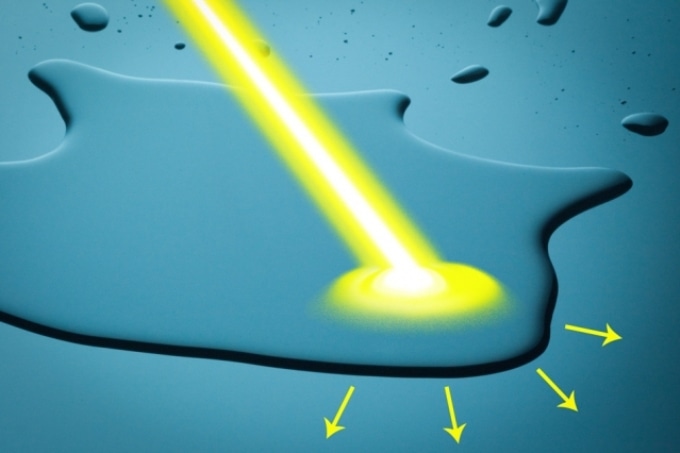Apr 26 2017
 A new system developed by MIT engineers could make it possible to control the way water moves over a surface, using only light. CREDIT: Jose-Luis Olivares/MIT.
A new system developed by MIT engineers could make it possible to control the way water moves over a surface, using only light. CREDIT: Jose-Luis Olivares/MIT.
Engineers from the MIT have developed an innovative system which uses only light to control the manner in which water moves over a surface. According to the researchers, the discovery might prove significant in the advancement of technologies such as field systems with the ability to separate water from oil at a drilling rig, or microfluidic diagnostic devices whose valves and channels can be reprogrammed on the go.
The system was created by MIT associate professor of mechanical engineering Kripa Varanasi, School of Engineering Professor of Teaching Innovation Gareth McKinley, former postdoc Gibum Kwon, graduate student Divya Panchanathan, former research scientist Seyed Mahmoudi, and Mohammed Gondal at the King Fahd University of Petroleum and Minerals in Saudi Arabia. A detailed description of the system has been provided in the Nature Communications journal.
The first aim of the research was to look for techniques to separate oil from water, for instance, to process the frothy mixture of crude oil and briny water generated from specific oil wells. If these mixtures are absolutely integrated, the droplets are very fine, so the constituent substances become very hard to separate. At times electrostatic techniques are employed for separating the constituent substances. However, the techniques are energy-intensive and do not hold good if the salinity of water is very high, which is the case more often. Alternatively, the researchers investigated the application of “photoresponsive” surfaces whose reactions to water can be modified by exposing them to light.
The researchers developed surfaces whose responses to water, or wettability, could be altered by light, and discovered that they have the ability to directly separate oil from water by making individual water droplets to coalesce and spread throughout the surface. The extent to which the water droplets get fused with each other determines the extent to which they get separated from oil.
There have been wide research and usage of photoresponsive materials. One such material is titanium dioxide, or titania, which is an active ingredient in many sunscreens. However, the photoresponsive materials, inclusive of titania, do not respond well to visible light as they respond to ultraviolet light. As only around 5% of sunlight is in the ultraviolet range, the research team worked out a technique for treating the surface of titania to enable it to respond to visible light.
In order to achieve this, they initially employed a layer-by-layer deposition method for constructing a film of polymer-bound titania particles on a glass layer. Subsequently, the material was dip-coated by means of a simple organic dye. The consequent surface was extremely responsive to visible light, resulting in alteration of the wettability upon exposure to sunlight, where the altered wettability was considerably higher when compared to that of the titania itself. Upon activation by sunlight, the material was found to be highly efficacious in “demulsifying” the oil-water mixture, that is, separating the water from oil.
We were inspired by the work in photovoltaics, where dye sensitization was used to improve the efficiency of absorption of solar radiation. The coupling of the dye to titania particles allows for the generation of charge carriers upon light illumination. This creates an electric potential difference to be established between the surface and the liquid upon illumination, and leads to a change in the wetting properties.
Kripa Varanasi, Associate Professor of Mechanical Engineering, MIT
“Saline water spreads out on our surface under illumination, but oil doesn’t,” stated Kwon, an assistant professor at the University of Kansas at present. “We found that virtually all the seawater will spread out on the surface and get separated from crude oil, under visible light.”
In a string of experiments, the researchers showed that a similar effect can be applied to propel water droplets across a surface. When the wettability of the material is selectively altered by means of a moving beam of light, a droplet can be made to move toward the more wettable area, thus accurately driving the droplet toward any desirable direction. Systems such as this can be developed to produce microfluidic devices sans built-in structures or boundaries. The movement of a fluid such as a blood sample in a diagnostic lab-on-a-chip can be completely regulated by means of the illumination pattern projected onto it.
By systematically studying the relationship between the energy levels of the dye and the wettability of the contacting liquid, we have come up with a framework for the design of these light-guided liquid manipulation systems. By choosing the right kind of dye, we can create a significant change in droplet dynamics. It’s light-induced motion—a touchless motion of droplets.
Kripa Varanasi, Associate Professor of Mechanical Engineering, MIT
One more advantage of the adjustable wettability of these surfaces is that they can be chiefly self-cleaning. If the surface is altered from being water-attracting, or hydrophilic, to water-repelling, or hydrophobic, the remnant water on the surface is driven off, thus carrying along any contaminants that may have been formed.
As the photoresponsive effect is mainly due to the dye coating, it can be favorably altered by selecting one of thousands of existing organic dyes. According to the researchers, almost all materials used in the technique are low-cost, universally accessible commodity materials, and the techniques for producing them are very normal.
The King Fahd University of Petroleum and Minerals supported the study through the Center for Clean Water and Clean Energy at MIT and KFUPM.